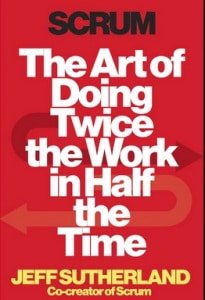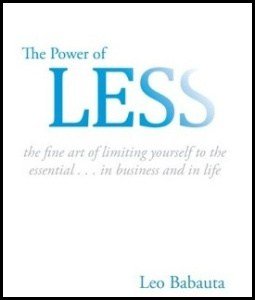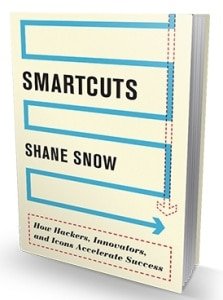Here is a book that will blow your mind! Because you will never do your work (alone or with others) the same way again.
Having taught college and high school, I found out the hard way that a lot of students hate group-work—and it’s no better in our adult careers. When you work with others, there’s always that:
* lazy guy;
* guy who doesn’t understand your obstacles and doesn’t care;
* merciless guy;
* dumb guy;
* disorganized guy;
* anal guy;
* micromanaging twerp;
* leader with no vision;
* gossip;
* people who overcomplicate;
* friction;
* and all of those things that you wish you could say.
In our hearts—perhaps subconsciously—we know if people were just a) straight-up and yet b) kind—it wouldn’t take so much time, money, and stress. But no. We’re still at work when we could have turned out a higher quality product three hours ago.
So when I stumbled across Scrum: The Art of Doing Twice the Work in Half the Time by Jeff Sutherland, I was skeptical at best, and cynical at worst. Until I started reading.
First of all, Scrum is so entertaining with its true stories that I read it three times. Then I gave copies away. And I realized:
It would be wrong to go back to teaching the same old way.
Wrong to work without this method.
Wrong to assign teen collaborations under the banner of: “Well, they’ll have to work with others in the real world.” The real world is dysfunctional and frustrating. People are working 50, 60, 70, and 80 hours per week and their stress level is through the roof.
And in the case of teens, it is simply not fair to stick one kid with all the work—because, with traditional group projects—that is happens 90+% of the time.
Scrum, however, is the process that Apple, Google, Microsoft are using to change the world (and make billions). Even nonprofits in the Third World are using it to get the food, medicine, and education to the people who need those things.
Amazingly simple, Scrum nonetheless was developed over a half-century, using cutting-edge business practices, the scientific method, and psychology. Further, they used the real world to refine it. After fifty years, you could say the peak performers are on Scrum 2.0 or 3.0, or maybe 10.0.
What is Scrum? It:
* Creates breakthroughs in technology;
* Establishes the perfect size for efficient groups;
* Tells you not to work more than 40-50 hours per week (unless you want to get burnt out fast);
* Works at the tech companies that have changed the world;
* Works in Finnish classrooms. The Finns from time to time are #1 in the world in education;
* Clarifies who is responsible for what;
* Simultaneously raises both justice and mercy;
* Maximizes teamwork by maximizing clarity, honesty, responsibility and empathy;
* Stops office politics and backstabbing cold;
* Helps workers thrive, not just be wage slaves; and
* Raises efficiency anywhere from 400 to 800%.
So, how does Scrum work? The last five pages summarizes everything. I will give you two nuggets:
News You Can Use #1: The Daily Standup.
Scrum advocates short meetings everyday—fifteen minutes or less. In the meeting, everyone stands in a circle.
Why stand? Because long meetings, like email, can be such a time-waster. So unproductive! So frustrating! Standing helps people get to the point.
As do these three questions, which everyone answers, everyday:
a) What did you do yesterday to move the project along?
b) What are you going to do today to move the project along?
c) What obstacles are getting in your way?
When I implemented Scrum with my high school juniors, I could smell their fear. That’s because some of them hadn’t done anything the previous day.
I was merciful at first: “Hey, kids, we’re just starting. Be honest. If you played video games for three hours, just say that.”
Because how much dishonesty—including deception by way of people just not saying anything—is in our workplaces?
That’s what question “c” is for. Suppose your co-worker didn’t get anything done yesterday—because she was at the hospital with her 100-year-old grandmother. Now other people in the group can say, “I didn’t know about that. How can I help?” Imagine the resentments this erases. Otherwise, it’s so tempting to write the other person off as lazy.
But what if the other person is lazy or inefficient?
Again, Scrum can help. Maybe they don’t know how to do one thing—and it’s holding up their work. Then, in the Daily Standup, someone else says, “I’ll teach you.”
Honesty makes everyone act smarter and go faster. Workplace clarity: up. Teamwork: up. Duplication of effort: down. Profits: up.
That sense that you’re thriving: way up.
News You Can Use #2: The Burn-Down Chart
The Burn-Down Chart is your To Do List, written on a big board where everyone can see it. It has three columns: To Do, Doing, and Done.
In “To Do,” on sticky notes, you list everything you ever wanted to do to complete your project. Then the group agrees on the #1 and #2 priorities, and works on those first. That way, everyone is doing all of the High Impact items first.
Thus, over time, every sticky note moves from “To Do,” to “Doing,” to “Done.”
News You Can Use #3: Save Time.
From Scrum: “Working Too Hard Only Makes More Work. Working long hours doesn’t get more done; it gets less done. Working too much results in fatigue, which leads to errors, which lead to having to fix the thing you just finished. Rather than work later on the weekends, work weekdays only at a sustainable pace. And take a vacation.”
Personally, I can only think of one exception: You love what you are doing. For example, maybe you’re Stephen King and you’re writing a novel.
News You Can Use #4: Save & Make Money.
We’re doing twice the work in half the time; the big tech firms use Scrum.
News You Can Use #5: Reduce Stress & Increase Happiness
From Scrum: “Hpapy people sell more stuff, make more money, cost les, are less likely to leave their jobs, are healthier, and live longer…. A 2005 paper that did a meta-analysis of some 225 papers with over 275,000 participants put it: ‘Happiness leads to success in nearly every domain of your lives, including marriage, health, friendship, community involvement, creativity, and in particular, our jobs, careers, and businesses.’”
Sounds like New Age or Kumbaya to some people, right? But think about people who quit. They aren’t happy. I have a feeling that ½ of Americans would viscerally disagree with the idea that happiness increases productivity—but that the other ½ would instinctively agree. After all, how hard is to keep working hard when you’re happy?
Further, Scrum helps us measure happiness.
“I’m going to give you a tool kit to measure your happiness and the happiness of your team, company, and family, as well as any organization you happen to be involved with. That’s what Scrum does.”
Brilliant. Simply brilliant.
Conclusion.
Obviously, any brilliant method—refined by the best people over 50 years—will have more to it than that. But I wanted to give you a few ideas to start with today.
And I really like the idea that if we actually put in a solid 40 hours with no distractions, we’d have more time for the rest of life. We’d concentrate just on the essentials—and thus thrive.
Scrum is what the top performers do. You will love it.
#
Little Green Book is a newsletter written by Tim Wuebker. Once a week, Tim describes an astonishing book, a real game changer, and/or a riveting read. Not only are these books thrilling, sometime they save you time, save you money, and increase your peace.
No author paid to receive a review. Tim wrote this for free because he loves these books.
The greatest compliments you can give Little Green Book and Tim is to subscribe to this newsletter, and then share it with anyone whom you think would find it fun or useful.
Tim also blogs at timwuebker.com
Source: Tims Old Blog





0 Comments